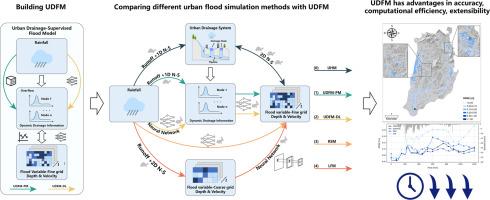当前位置:
X-MOL 学术
›
Water Res.
›
论文详情
Our official English website, www.x-mol.net, welcomes your
feedback! (Note: you will need to create a separate account there.)
Incorporating Dynamic Drainage Supervision into Deep Learning for Accurate Real-Time Flood Simulation in Urban Areas
Water Research ( IF 11.4 ) Pub Date : 2024-11-19 , DOI: 10.1016/j.watres.2024.122816 Hancheng Ren, Bo Pang, Gang Zhao, Haijun Yu, Peinan Tian, Chenran Xie
Water Research ( IF 11.4 ) Pub Date : 2024-11-19 , DOI: 10.1016/j.watres.2024.122816 Hancheng Ren, Bo Pang, Gang Zhao, Haijun Yu, Peinan Tian, Chenran Xie

|
Urban flooding has become a prevalent issue in cities worldwide. Urban flood dynamics differ significantly from those in natural watersheds, primarily because of the intricate drainage systems and the high spatial heterogeneity of urban surfaces, which pose considerable challenges for accurate and rapid flood simulation. In this study, an urban drainage-supervised flood model (UDFM) for urban flood simulation is proposed. The urban flood process is decoupled into drainage routing and surface flood inundation. On the basis of physical and deep learning drainage models, a hybrid module combining deep learning and dimensionality reduction algorithm is adopted to convert the 1D drainage overflow process into a high-resolution, spatiotemporal 2D pluvial flooding process. Compared with existing state-of-the-art surrogate models for rapid flood simulation, the UDFM more comprehensively and accurately represents the role of drainage systems in urban flood dynamics, providing high-resolution predictions of flood depth and velocity. When applied to a highly urbanized district in Shenzhen, UDFM-deep learning demonstrated real-time predictive capabilities and high accuracy, particularly in simulating flow velocity, with average Nash efficiency coefficients improved by 0.112 and 0.251 compared with those of a response surface model (RSM) and a low-fidelity model (LFM), respectively. These findings underscore the critical importance of drainage system overflow in urban surface flood simulations. The UDFM enhances accuracy, flexibility, interpretability, and extensibility without requiring additional physical model construction. This research introduces a novel hierarchical surrogate model structure for urban flood simulation, offering valuable insights for rapid flood warning and risk management in urban environments.
中文翻译:

将动态排水监督整合到深度学习中,以实现城市地区的准确实时洪水模拟
城市洪涝已成为全球城市普遍存在的问题。城市洪水动力学与自然流域的洪水动力学有很大不同,主要是因为错综复杂的排水系统和城市表面的高度空间异质性,这对准确和快速的洪水模拟构成了相当大的挑战。该文提出一种用于城市洪涝模拟的城市排水监督洪水模型 (UDFM)。城市洪水过程被解耦为排水路线和地表洪水泛滥。在物理和深度学习排水模型的基础上,采用深度学习和降维算法相结合的混合模块,将一维排水溢流过程转换为高分辨率、时空的二维冲积洪水过程。与现有的最先进的快速洪水模拟替代模型相比,UDFM 更全面、更准确地代表了排水系统在城市洪水动力学中的作用,提供了洪水深度和速度的高分辨率预测。当应用于深圳的一个高度城市化地区时,UDFM 深度学习表现出实时预测能力和高精度,特别是在模拟流速方面,与响应面模型 (RSM) 和低保真模型 (LFM) 相比,平均 Nash 效率系数分别提高了 0.112 和 0.251。这些发现强调了排水系统溢流在城市地表洪水模拟中的极端重要性。UDFM 提高了准确性、灵活性、可解释性和可扩展性,而无需额外的物理模型构建。 本研究为城市洪水模拟引入了一种新的分层代理模型结构,为城市环境中的快速洪水预警和风险管理提供了有价值的见解。
更新日期:2024-11-19
中文翻译:

将动态排水监督整合到深度学习中,以实现城市地区的准确实时洪水模拟
城市洪涝已成为全球城市普遍存在的问题。城市洪水动力学与自然流域的洪水动力学有很大不同,主要是因为错综复杂的排水系统和城市表面的高度空间异质性,这对准确和快速的洪水模拟构成了相当大的挑战。该文提出一种用于城市洪涝模拟的城市排水监督洪水模型 (UDFM)。城市洪水过程被解耦为排水路线和地表洪水泛滥。在物理和深度学习排水模型的基础上,采用深度学习和降维算法相结合的混合模块,将一维排水溢流过程转换为高分辨率、时空的二维冲积洪水过程。与现有的最先进的快速洪水模拟替代模型相比,UDFM 更全面、更准确地代表了排水系统在城市洪水动力学中的作用,提供了洪水深度和速度的高分辨率预测。当应用于深圳的一个高度城市化地区时,UDFM 深度学习表现出实时预测能力和高精度,特别是在模拟流速方面,与响应面模型 (RSM) 和低保真模型 (LFM) 相比,平均 Nash 效率系数分别提高了 0.112 和 0.251。这些发现强调了排水系统溢流在城市地表洪水模拟中的极端重要性。UDFM 提高了准确性、灵活性、可解释性和可扩展性,而无需额外的物理模型构建。 本研究为城市洪水模拟引入了一种新的分层代理模型结构,为城市环境中的快速洪水预警和风险管理提供了有价值的见解。


















































 京公网安备 11010802027423号
京公网安备 11010802027423号